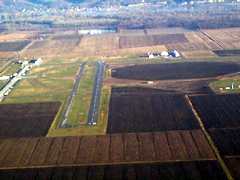
Joseph Gillespie Smartt |
Kaneohe Naval Air Station |

Additional Information USS Smartt (DD-257) (Click on star to access information) |
St Charles County Smartt Airport St Charles, Missouri, USA The number of cadets being trained kept increasing so the Navy purchased several hundred acres of land in St. Charles County near where the Illinois River entered the Mississippi River. This became an auxiliary landing field for the cadets to practice takeoffs and landings. For several months every morning, Chief Thomas would load the 1927 federal truck with seamen and shovels and we would spend the day digging drainage ditches and leveling off enough of the field for a runway. The trip over the roads of that day and through the city of St. Charles would take about an hour. Cruising speed in the Federal was probably about 25-30 miles per hour. Chief Thomas had a certain saloon in Boschertown on Hwy. 94 that we would stop at on our way there and on the way back. The building is still there and the saloon may still be in operation. The airport was called Smartt Field after Ensign Joseph Gillespie Smartt, a Naval Aviator, who started his flight training at NRAB St. Louis and was cited for bravery when the Japs attacked Pearl Harbor. Information from the 1958 files of the CNO revealed that the stepfather of Ensign Joseph Gillespie Smartt wanted to know if Smartt field was named after his stepson. The Dallas Historical Society was trying to accumulate, for filing in their archives in the Dallas Hall of Fame, the records of all Dallas men on whom honors were bestowed during WW2. Some of the 9 pages of information from CNO Archives are typed, some hand written, and some contradicted notes on other pages. Dates of purchase of the land and commissioning of the field vary. The first documented mention of the field, dated 25 Nov. 1942, referred to it as "Outlying Field #34512". A letter dated 28 May, 1943 refers to it as "Neubeiser Field". The land was purchased from Ruth M. Neubeiser in April of 1943. Apparently it was leased before that because we remember shoveling dirt there in late 1941 or early 1942. It's location was given as Lat. 38º56', Long 90º25'; about 11 miles northwest of Lambert Field. "28 Mar 1948 - NAS St, Louis History Report states that field was hit by a tornado shortly after it had been placed in an inactive status. (Cdr. Bart Slattery says that the men were securing the gate just as the tornado hit)." "Ninth Naval District War Diaries from Nov. 1942 - 14 July 1943 mention the field only once and that in an entry for 13 March 1943 regarding receipt of Chevrolet Crash Truck for use at Smart Field. (Curiously enough, the typist spelled it with 2 'T's but erased one.)"Chief Rocco please note. "BuAer News Ltr 1 Sep. 1942 notes: Ensign Joseph Gillespie Smartt as among those cited by CinCPacFlt, 'For prompt and efficient action and utter disregard of personal danger in the effort to repel the attack on Naval Air Station, Kaneohe Bay, Oahu, Territory of Hawaii, by Japanese forces on December 7th, 1941, which was made in conjunction with the attack on the fleet in Pearl Harbor on that date." The last letter states that the CNO informed Mr. W.H. Thomson that Smartt Field was, in fact, named in honor of his stepson, Ensign Joseph Gillespie Smartt. Ensign Smartt had started his flight training at NRAB, St. Louis and was cited for bravery very early in the war. When the United States entered the war and student training was greatly expanded a large hexagon shaped blacktop area was added with a pair of runways every 60 degrees so you were never more than 30 degrees out of the wind. This same shape and design was used in hundreds of primary training fields (Navy and Army Air Corps) around the country. A large hangar and aircraft workshop was added and later, barracks and mess halls. Today some remnants of the old blacktop remain and the hangar, the only one of the buildings remaining, has historical significance and is used by the local wing of the Confederate Air Force. The airport is now called St Charles County Smartt Airport. |
